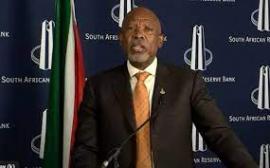
The South African Reserve Bank’s Monetary Policy Committee (MPC) has decided to keep the repurchase rate at its current level of 8.25% per year.
Announing the MPC’s decision on the repo rate, Reserve Bank Governor Lesetja Kganyago said three members of the Committee preferred to keep rates on hold and two preferred an increase of 25 basis points.
“At the current repurchase rate level, policy is restrictive, consistent with elevated inflation expectations and the inflation outlook. Serious upside risks to the inflation outlook remain. In light of these risks, the Committee remains vigilant and decisions will continue to be data dependent and sensitive to the balance of risks to the outlook,” Kganyago said on Thursday.
He said while South Africa’s economic conditions appear to have improved, the longer-term outlook mirrors the uncertainty of the global environment.
“Prices for commodity exports continue to weaken. In addition, energy supply remains unreliable and stronger El Nino conditions threaten the agricultural outlook. For 2023, the Bank’s forecast for South Africa’s GDP growth is slightly higher than in May, at 0.4% (from 0.3%).
“Energy and logistical constraints remain binding on the growth outlook, limiting economic activity and increasing costs. From a demand perspective, spending by firms, households, public corporations and general government remains positive in real terms. Disposable income of households continues to grow, albeit slowly. Investment by the private and public sectors is revised up and the terms of trade has remained more beneficial than previously forecast,” Kganyago said.
Debt service costs of households have increased to 8.4% of disposable income, and now sit at around the average for the past decade.
“Although credit growth to households and corporates has slowed in recent months, it has increased in real terms compared to last year. Our GDP growth forecast for 2024 and 2025 is unchanged from the previous meeting, at 1.0% and 1.1%, respectively.
“While households and firms exhibit resilience, economic growth has been volatile for some time and highly sensitive to new shocks. An improvement in logistics and a sustained reduction in load-shedding, or greater energy supply from alternative sources, would significantly increase growth.
“At present, we assess the risks to the medium-term domestic growth outlook to be balanced. Turning to inflation prospects, our current growth forecast leaves the output gap around zero over the next three years, implying little positive or negative pressure on inflation from GDP growth,” he said.
Kganyago said South Africa’s external financing needs are expected to rise due to expansion in the current account deficit.
“Despite somewhat lower oil prices, falling export commodity prices are forecast to result in a current account deficit of 1.9% of GDP this year (down from 2.5%), 2.9% and 3.3% of GDP in 2024 and 2025, respectively.
“Sharply lower tax revenue, higher employee compensation and ongoing financing needs of state-owned enterprises are likely to keep the long-term cost of borrowing elevated. Despite the expected moderation of inflation over the forecast period, long-term bond yields currently trade at about 11.6%,” he said.
He noted that the rand has generally weakened over the past year, depreciating by about 5% year to date against the US dollar, and showing high volatility in response to risk-on and risk-off episodes.
“The trajectory of South Africa’s headline inflation rate has been shaped primarily by fuel, electricity and food price inflation. Compared to the previous meeting, fuel price inflation is lower at -3.1% in 2023 (from -2.0%).
“The electricity price forecast is unchanged at 11.6% this year, 13.4% in 2024, and 10.9% in 2025. Our food price inflation forecast for 2023 remains high but is revised lower in this meeting to 10.3% (from 10.8%), and up slightly to 5.2% in 2024 (from 5.0%),” the Governor said.
He credited better monthly outcomes to a downward revision in the forecast for core inflation to 5.2% in 2023 (previously 5.3%), 4.9% (from 5.0%) and 4.5% (from 4.6%) in 2024 and 2025, respectively.
“Services price inflation in 2023 is expected to come in at 4.8% (down from 4.9%). Core goods inflation, while still elevated, is also revised slightly lower for this year at 6.2% (from 6.3%).
“Growth in average salaries and unit labour costs is lower in 2023 and 2024 and slightly higher in 2025. With core goods and food inflation lower in the near term, headline inflation for 2023 is revised down to 6.0% (from 6.2%). The headline inflation forecast for 2024 also decreases to 5.0%, before stabilising at 4.5% in 2025,” Kganyago said.
Despite recent easing in some food price components, domestic food price inflation is still elevated at 11% in June and the risk of drier weather conditions in coming months has increased.
The Bureau for Economic Research survey released in July shows average inflation expectations of 6.5% for 2023 (from 6.3% in the first quarter).
“Expectations for inflation in 2023 based on market surveys are currently 5.9%, and near-term breakeven rates have decreased to around 4.5%. Longer-term expectations remain elevated,” the Governor said. – SAnews.gov.za


